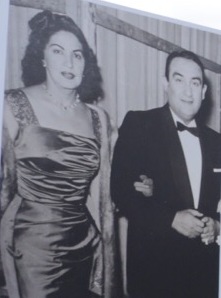Consuelo Velázquez facts for kids
Consuelo Velázquez Torres (born August 21, 1916, in Ciudad Guzmán, Jalisco – died January 22, 2005, in Mexico City), often called Consuelito Velázquez, was a famous Mexican concert pianist and a talented composer. She wrote many well-known Mexican songs, including the worldwide hit "Bésame mucho", "Amar y vivir", and "Cachito".
Contents
Early Life and Music
Consuelo was born in Ciudad Guzmán, Mexico. She was the youngest of five daughters. From a very young age, she showed a great talent for music. When she was just four years old, she had a good ear for melodies.
At six, she started studying music and piano in Guadalajara. When she was eleven, she moved to Mexico City. There, she continued her studies at the National Conservatory of Music. She earned a degree in music teaching and concert piano.
Her first public concert was at the Palacio de Bellas Artes in Mexico City. Soon after, she began writing popular music. As a concert pianist, she played as a soloist with Mexico's National Symphony Orchestra. She also performed with the Philharmonic Orchestra of the National Autonomous University of Mexico.
In her early career, performing on the radio was unusual for a young woman from a wealthy family. So, Consuelo used a male name for her first songs. The artistic director of the radio station, Mariano Rivera Conde, encouraged her to reveal she was the real author. Six years later, Consuelo married him.
A Gifted Composer
Consuelo Velázquez is most famous for her work as a composer. Her first songs, like "No me pidas nunca" and "Pasional", were romantic. They often focused on the beauty of nature.
Later, she wrote many other popular songs. These include "Bésame mucho", "Amar y vivir", "Que seas feliz", and "Yo no fui". "Yo no fui" became a popular dance song. It was first sung by Pedro Infante and later by Pedro Fernández.
Consuelo also appeared in a few movies. She acted in the Argentinian movie Noches de Carnaval in 1938. She also played piano in Mexican movies like Se le pasó la mano (1952) and Mis padres se divorcian (1959). In 1992, a documentary about her life, Consuelo Velázquez, was made.
The Famous "Bésame Mucho"
Her most well-known song is "Bésame mucho". She wrote this iconic song when she was only 16 years old. It is a bolero, a type of Cuban music.
Interestingly, Consuelo wrote "Bésame mucho" before she had ever received her first kiss from someone she loved. This song brought her the most fame and joy.
After being recorded by Emilio Tuero, an American singer named Nat "King" Cole made the first English version in 1944. From then on, hundreds of artists worldwide sang it. Famous performers include The Beatles, Plácido Domingo, Frank Sinatra, Luis Miguel, and Andrea Bocelli.
"Bésame mucho" has been translated into more than 20 languages. It is also known by names like "Kiss Me Kiss Me Much" and "Embrasse-Moi". The song became very popular in the United States during World War II. It was seen as a song for women waiting for their husbands to return from the war.
Personal Life and Legacy
Consuelo Velázquez married Mariano Rivera Conde, who owned a media company. They had two sons, Mariano and Sergio. Mariano Rivera Conde passed away in 1977.
From 1979 to 1982, Consuelo was a member of the Chamber of Deputies. This was her only involvement in politics. In 1989, she won the National Prize for Science and Arts. This award recognized her contributions to popular art.
In 1977, she also received the Award of Peace from the United Nations. She got this award for her artistic work and for helping organize a Mexican festival for the United Nations staff.
Consuelo Velázquez passed away on January 22, 2005, due to heart problems. Her body was taken to the Palacio de Bellas Artes for a tribute. This was the same place where she had her first public concert. Her ashes were later buried in the Santo Tomas Moro church, where she attended mass every Sunday.
Before she died, Consuelo played piano on the album Para mi... Consuelo by Mexican singer Cecilia Toussaint. This album featured songs written by Consuelo. It was her last artistic contribution.
Recently, it was found that Consuelo left seven unreleased songs. These include "Donde siempre" and "Mi bello Mazatlán". She also left a song called "Por el camino" for the Mexican singer Luis Miguel.
See also
 In Spanish: Consuelo Velázquez para niños
In Spanish: Consuelo Velázquez para niños


